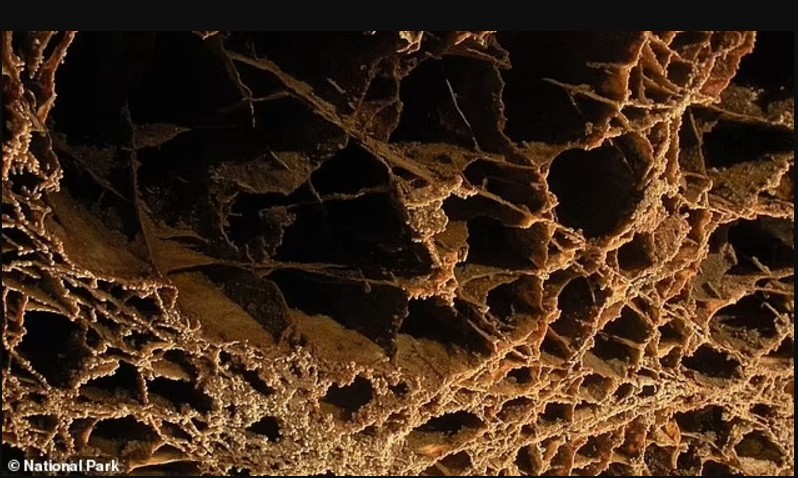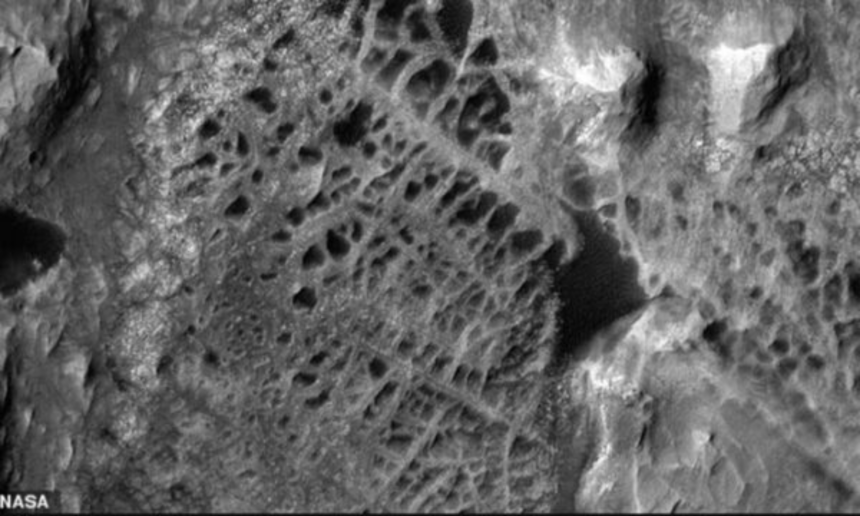NASA has discovered mysterious “spider web” patterns in a region near Mars’ equator that has never been explored before.
NASA’s Curiosity rover has been sent to investigate these strange structures—which cover an area of six to twelve miles of Martian desert—while searching for signs that the barren planet may have once supported alien life.
Geologists suspect that these spider web-like patterns are a giant version of a type of crystallized mineral known as “boxwork,” which appears inside certain caves on Earth. These formations can be found in the ceiling of Wind Cave in South Dakota, created by mineral-rich waters with calcium carbonate that penetrated cracks between softer rocks and solidified into crystals.
However, the sprawling web, which stretches over 3,800 acres on Mars, differs in that it might have formed from ancient Martian seas and could have captured fossils of ancient life within its structure.
“These ridges will contain minerals in the form of crystals beneath the surface, where it could have been warmer,” said Dr. Kirsten Siebach, a geologist at Rice University. “Microbial life on early Earth may have survived in a similar environment,” she explained, emphasizing that the “saline liquid water” that formed these Martian webs is an ideal place to search for fossil evidence of ancient alien microbes.
This discovery comes as Australian researchers have found further evidence that a Martian meteorite, which fell in Northwest Africa, offers more clues to the presence of warm water on Mars.
A chemical analysis of this meteorite suggests that conditions were suitable for the development of aquatic life on the neighboring planet more than four billion years ago. Since its landing on Mars’ surface on August 6, 2012, the Curiosity rover has been exploring the Red Planet in search of signs of life—as well as gathering data on the climate, geology, and fate of ancient water on Mars.
But NASA researchers have been intrigued by this massive geological “spider web” for a long time, since their Mars Reconnaissance Orbiter first captured aerial images of this strange landscape on December 10, 2006.
How these formations may have appeared on the surface of Mars remains a mystery, but theories suggest it could be linked to the chaotic climate that stripped Mars of its water billions of years ago.
The possibility that evidence of ancient microbial life on Mars could be trapped in this giant web as fossils “makes this an exciting place for exploration,” noted Dr. Siebach.
This possible web of alien microbes and dead alien insects lies beneath the shadow of a three-mile-high mountain officially known as “Aeolis Mons,” but commonly referred to as “Mount Sharp.”
Previous explorations by the Curiosity rover have discovered many sedimentary layers along the rocky faces of Mount Sharp, suggesting in rich detail that they were formed by the erosion of water through ancient lake deposits.
NASA scientists suspect that erosion helped form the giant crystal web, as pulses of mineral-rich water seeped down from the slopes of Mount Sharp, penetrating cracks in the surface rocks and then crystallized.
According to mapping work published by Dr. Kirsten Siebach in 2014, at least 113.6 billion gallons of warm, salty mineral water would have been needed to create the vast crystal web field, which is larger than Los Angeles International Airport (LAX). “This is a significant amount of underground water that must have been present,” she and her co-author wrote in an article for the Journal of Geophysical Research: Planets, as reported by GazetaExpress.
“Mineralization,” the type of crystal formation that likely occurred here, “is known on Earth for helping preserve once-habitable environments,” they emphasized.
Meanwhile, this month in Australia, scientists working with the Martian meteorite NWA 7034, which fell in Northwest Africa, have discovered further proof that ancient warm oceans on Mars may have easily supported alien life.
“We used nanoscience to uncover elemental evidence of hot water on Mars 4.45 billion years ago,” said planetary scientist Dr. Aaron Cavosie in a statement.
“Geochemical signatures of water” were discovered in the NWA 7034 meteorite, explained Dr. Cavosie, both in the form of its rock grain structures and its chemical composition: “clear signs of water-rich liquids from the time when the grains were formed.”
It is thought that NWA 7034 was ejected from Mars by an asteroid impact, which created a crater in the northeastern part of the Terra Cimmeria-Sirenum province in Mars’ southern hemisphere.
A special technique used to determine the age of the exceptionally old zircon minerals through trace amounts of radioactive materials, called “uranium-lead dating,” revealed that this meteorite is made of some of the oldest volcanic Martian rocks ever obtained.
“The team identified elemental patterns in this unique zircon, including iron, aluminum, yttrium, and sodium,” said Dr. Cavosie, “through imaging and nanoscale spectroscopy.”
“These elements were incorporated as the zircon formed 4.45 billion years ago,” he continued, “suggesting that water was present during early Martian magmatic activity.”
This mixture of hot, mineral-rich water, similar to hydrothermal resources that support life in the deep oceans of Earth, suggests that life could have been developing on Mars billions of years ago, amidst all this volcanic activity.
“Hydrothermal systems were critical for the development of life on Earth,” explained Dr. Cavosie, “and our findings suggest that Mars also had water, a key ingredient for habitable environments, during the early formation of its crust.”
The Australian planetary scientist and his team at Curtin University in Australia published their results in Science Advances last Friday.
Over more than a decade on the Red Planet, NASA’s Curiosity rover has traveled about 20 miles across the Martian surface to search for evidence of life that may have once flourished there.
Curiosity is set to begin studying the spider web ridges closely in 2025, according to NASA Administrator Bill Nelson, who stated that the rover will undertake a “one-month journey through Mars’ crystalline web.”











